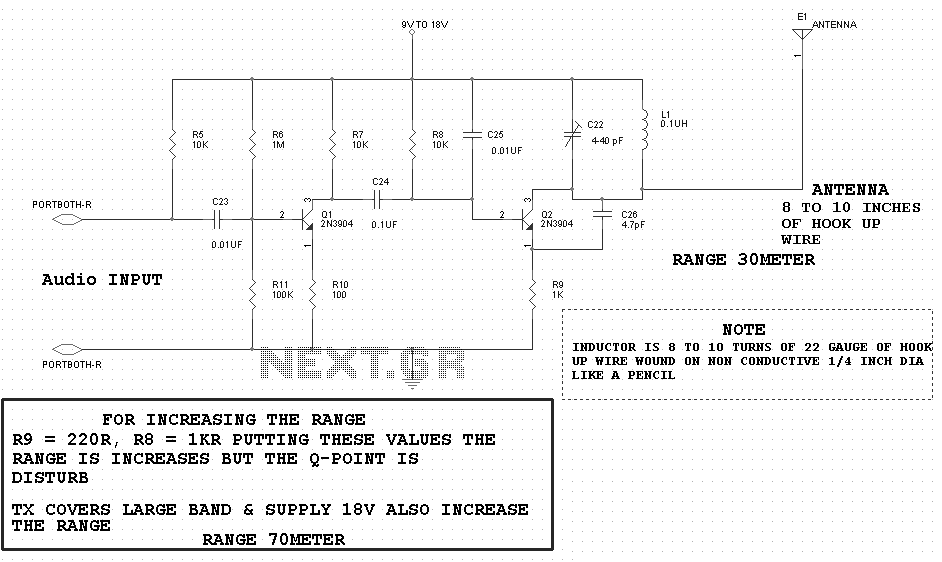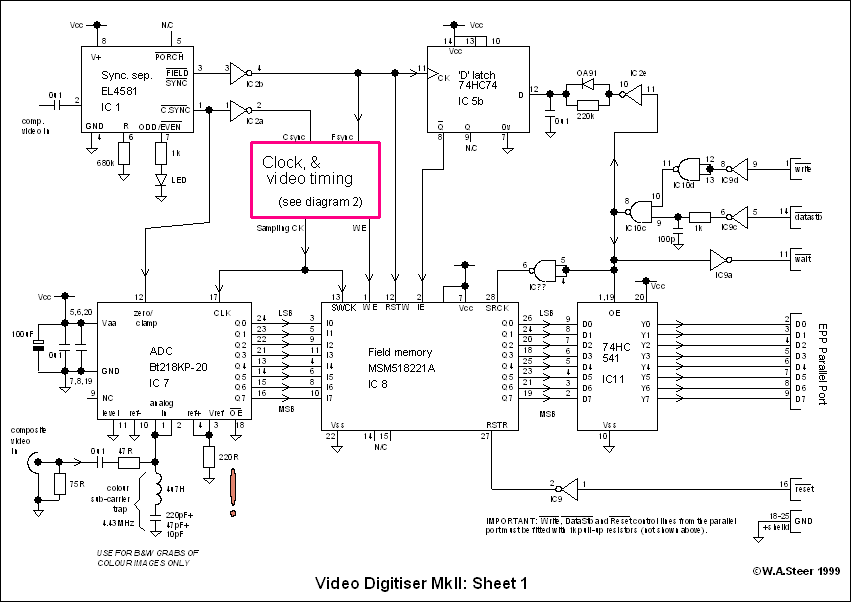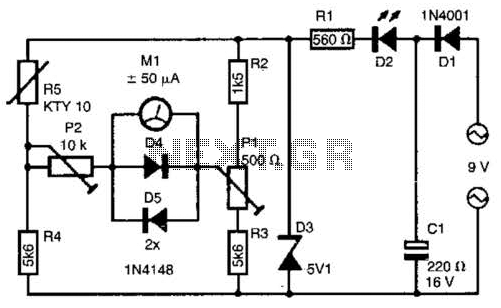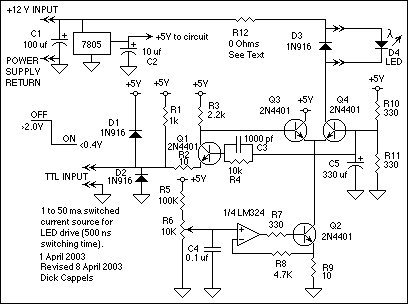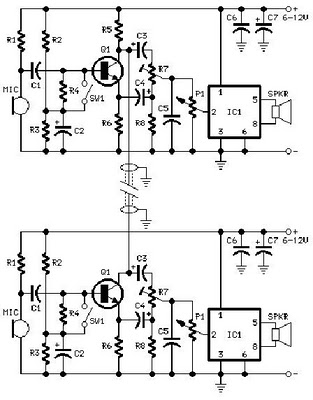
The Link Telephone Intercom Every Home Should Have One!
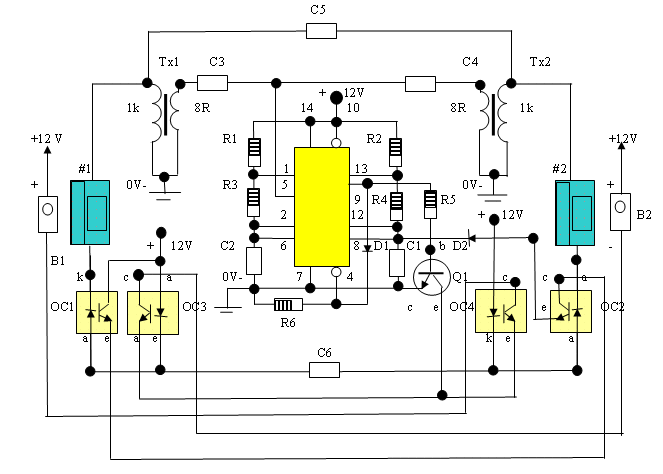
The Link circuitry is simple and efficient, employing just two integrated circuits (ICs), a few transistors, and common components. It operates on 12 volts and is easy to assemble. This intercom system can connect various locations such as the kitchen, garage, rumpus room, and poolside bar for under $100. The Link intercom is designed to allow users to purchase parts from standard electronics retailers. It utilizes old pulse dial handsets and replaces the AC bell set with a 9-volt DC buzzer. The entire circuit is powered by a regulated 12-volt DC supply, suitable for short-term battery operation. It can be used for events like radio field days or in settings such as pre-schools, nursing homes, scout halls, churches, and even small offices or workshops. The system supports one call at a time within a range of approximately 100 meters from the main unit and is not compatible with the public switched telephone network due to voltage and current limitations. The Link operates with a minimal current draw of around 200 mA from a 12-volt supply, which can be provided by a simple DC plug pack connected to a 7812 regulator chip with appropriate filtering capacitors.
The Link intercom is structured around two integrated circuits. The first, an NE 556 dual timer chip (IC1), generates dial tone, ring tone, and ring pulses for the ringer circuit. The second, a CD 4017B decade counter (IC2), counts the dial pulses received and is buffered by two opto-couplers (OC1 and OC2) along with their associated resistor-capacitor (R/C) networks. Each handset connects through a four-wire circuit from the main unit, with two wires dedicated to speech and dialing, and the other two for ring pulses delivered to the DC buzzer in each handset.
When a phone is lifted off-hook, a DC loop is established through the internal circuitry of the phone, the transformer (TX), and back to ground. The dial tone is provided to the calling handset when the Link is in reset condition via a capacitor and the transformer winding. The tones are generated by IC1a, while ring pulses are produced by IC1b. When a handset is off-hook, the opto-couplers activate, pulling specific pins of the decade counter to ground. As the dial is used, the counter receives pulses and registers the number dialed, allowing the corresponding output pin to activate the ringer for the intended handset.
The system’s design allows for a maximum of ten pulses in a single dialing sequence, with the counter stepping through its outputs to connect to the appropriate ringer circuit. The logic of the counter ensures that when a number is dialed, the corresponding output pin activates, signaling the ringer circuit to alert the called party.
Upon dialing, the system transitions from a dial tone to a ringing signal, and when the called party answers, the circuit halts the ringing tones. This is achieved through a transistor that detects both handsets being off-hook, effectively managing the call state and restoring the system to its idle state once the call concludes. The Link intercom system is designed to be straightforward yet effective, utilizing basic counting and pulsing techniques to facilitate communication across short distances.
For assembly, a printed circuit board (PCB) or matrix board can be employed, with IC sockets for easy replacement of the chips. A housing box and terminal blocks can enhance the professional appearance of the installation. It is important to note that leaving a handset off-hook will lock the system, and picking up a phone while another is dialing may result in incorrect dialing. The design emphasizes usability and cost-effectiveness while maintaining functionality for various applications.The Link circuitry is simple and efficient, employing just two ICs, half a dozen transistors, and a handful of garden variety components. It all runs on 12 volts and is easily assembled. You can have your own home intercom between the kitchen, the garage, the rumpus room and at your poolside barby` and all for less than $100!
The Link intercom has been designed in such a way that you can buy parts for it off the shelf` at just about any decent electronics retail chain. It uses old pulse dial handsets and replaces the AC bell set with a 9 volt DC buzzer. The whole circuit runs from a 12 volt regulated DC supply and is suitable for short term battery operation (eg: Gel Cell`).
It is suitable for radio field days and sporting events (providing you can scrounge enough 4 wire cable) and may find a place in pre-schools, old folk`s homes, boy scout/girl guide halls, churches, kids` tree houses/fortresses, or maybe even more serious uses such as small offices, factories, workshops and many other applications. The Link is designed to enable one call at a time within a small area (about 100 meters from the black box` is about the max per handset) and is not suitable for connection to the PSTN (public network) as the voltages and currents used by the PSTN are higher, and will damage the simpler 12 volt circuitry, that employs CMOS ICs etc.
The Link will run quite happily off a 12 volt regulated DC supply of only 200mA or so, and this can be a simple affair, such as a DC plug pack, wired to a 7812 regulator chip and appropriate filter caps on the output. Add some leds if you want! The Link telephone intercom is designed around two ICs. The first, IC1, is an NE 556 dual timer chip, which is wired up to provide dial tone, ring tone (busy tone too, which will be explained along with a few add-ons to be mentioned later on) and ring pulses for the ringer circuit attached to each line circuit.
The other chip, IC 2, is a CD 4017B decade counter, which is wired to count each train of dial pulses as they are received and buffered by the two opto-couplers, OC1 and OC 2 and their associated R/C networks. Each phone handset is connected by a four wire circuit from the black box`. Two wires (normally tagged white` and blue` here in Oz) are for speech and dialing functions, whereas the other two (tagged locally as red` and black`) are for the ring pulses supplied by the ringer circuit to each DC buzzer inside the handsets.
When a phone (eg: #1 for our discussion) is picked up in its off hook` condition, a DC loop is formed by the following components: DC circuitry inside the phone, the 1K winding of transformer TX, and back to 0V- earth. Taken from the +12 volts terminal, through the Leds inside OC1 and OC2 and back to the phone handset.
Dial tone is provided to the calling party`s phone when the Link is in its reset` condition (no calls in progress) via capacitor C3 and the 8 ohm winding (8R) of TX to 0v- earth. This and the other service tones are generated by IC1a, while ring pulses are generated by IC1b. When a calling party`s phone is off hook`, the leds force the photo transistors to switch on hard, pulling pins 13 and 14 of IC2 to 0 volts ground.
When the dial inside the phone handset is pulled back and released, the collector lead of OC2`s transistor is held low at 0 volts by the slow release charging of C5. Pin 13 of IC2 is a CE (chip enable) input, and needs to stay at a logic low (near 0 volts) to enable pin 14 to count the dial pulses.
So while impulsing` occurs, pin 13 stays low, and pin 14 alternates between logic high and low as the led emulates each dial pulse train, until the last pulse in the train is received. When caller number #1 dials phone number # 4, those four pulses appear across the leds inside OC1 and OC2.
The decade counter, acting as a Register (a storage device used in communications equipment for storing dialed digits) counts these pulses, turning its output pins on and off inn unison, with the last dial pulse causing the counter to rest on the last output pin that is turned on. The complete sequence for a maximum of ten pulses in the one pulse train, is (pin 3 is always at logic high at reset`) 2, 4, 7, 10, and then 1, 5, 6, 9, 11 and then finally pin 3.
So when the number 4` is dialed, the counter would step through pins 2, 4, 7, and then land on pin 10, which is connected to phone #4`s ringer circuit via Q4`s base lead. Each line circuit consists of the individual phone handset, the DC buzzer mounted inside it, the common connections to TX and the cathode of OC2`s led, as well as transistors Q1 to Q4 and common driver transistor Q5.
With pin 3 of IC2 at logic high on reset`, diode D3 enables IC2a to provide a Dial Tone from pin 5. When a number is dialed, pin 3 of IC2 goes low on the first dial pulse, removing the logic high via D4 from pins 12 and 8 of IC1b, thus enabling it to charge up C3, and produce ring pulses to IC1a via diode D5, (from pin 9 to pin 4). After about 2 seconds, ring pulses commence, and the modulated dial tone (which then by default becomes an interrupted Ring Tone to the caller) is produced at pin 5 of IC1a, indicating the progress of the call.
When the called party answers the call, transistor QX with trimpot R6, (adjusted to detect both phones being off-hook`, ) triggers the led and phototransistor inside OC3. This halts the ring pulses and ring tone supplied by IC1a and IC1b for the duration of that call, by supplying a logic high potential to pins 12 and 8 of IC1b via D6.
When the call is over, and both parties have hung up their phone handsets (eg: back to the on-hook` status, ) the DC loop formed by the handsets, TX and OC1/OC2 is broken. Pin 13 of IC2 returns to its reset potential of logic high, and extends this high to pin 15 (Reset) of the 4017 decade counter chip, which disables the output selected during the dialing operation, and enables pin 3 to high, thus restoring Dial Tone to the next caller via pin 4 of IC1a.
Thus the Link is fully reset and ready for another call. As you can see, it may seem a little complicated to follow the progression through a call, particularly if you haven`t been involved with phones and logic chips much before. At the end of the day, you have some simple counting, pulsing and interfacing circuitry, which will perform all the necessary tasks of a basic intercom, and all at a reasonable cost.
I used some formatted matrix board for the p. c. b and IC sockets for all ICs and OC/OC2. I also found that a heat sink fin for the 7812 regulator chip was unnecessary. A box could be used for housing the Link circuitry, and some kind of screw terminal block or ID block (like a small 10 pair KRONE junction box) could be used to terminate the wiring at the box to make it look more professional. Remember these two things. If you leave a phone off-hook` you will lock up the Link and if you pick up a phone when someone else is dialing, wrong numbers will result.
Apart from that, have fun! Austin Hellier 08-Oct-2003 🔗 External reference
The Link intercom is structured around two integrated circuits. The first, an NE 556 dual timer chip (IC1), generates dial tone, ring tone, and ring pulses for the ringer circuit. The second, a CD 4017B decade counter (IC2), counts the dial pulses received and is buffered by two opto-couplers (OC1 and OC2) along with their associated resistor-capacitor (R/C) networks. Each handset connects through a four-wire circuit from the main unit, with two wires dedicated to speech and dialing, and the other two for ring pulses delivered to the DC buzzer in each handset.
When a phone is lifted off-hook, a DC loop is established through the internal circuitry of the phone, the transformer (TX), and back to ground. The dial tone is provided to the calling handset when the Link is in reset condition via a capacitor and the transformer winding. The tones are generated by IC1a, while ring pulses are produced by IC1b. When a handset is off-hook, the opto-couplers activate, pulling specific pins of the decade counter to ground. As the dial is used, the counter receives pulses and registers the number dialed, allowing the corresponding output pin to activate the ringer for the intended handset.
The system’s design allows for a maximum of ten pulses in a single dialing sequence, with the counter stepping through its outputs to connect to the appropriate ringer circuit. The logic of the counter ensures that when a number is dialed, the corresponding output pin activates, signaling the ringer circuit to alert the called party.
Upon dialing, the system transitions from a dial tone to a ringing signal, and when the called party answers, the circuit halts the ringing tones. This is achieved through a transistor that detects both handsets being off-hook, effectively managing the call state and restoring the system to its idle state once the call concludes. The Link intercom system is designed to be straightforward yet effective, utilizing basic counting and pulsing techniques to facilitate communication across short distances.
For assembly, a printed circuit board (PCB) or matrix board can be employed, with IC sockets for easy replacement of the chips. A housing box and terminal blocks can enhance the professional appearance of the installation. It is important to note that leaving a handset off-hook will lock the system, and picking up a phone while another is dialing may result in incorrect dialing. The design emphasizes usability and cost-effectiveness while maintaining functionality for various applications.The Link circuitry is simple and efficient, employing just two ICs, half a dozen transistors, and a handful of garden variety components. It all runs on 12 volts and is easily assembled. You can have your own home intercom between the kitchen, the garage, the rumpus room and at your poolside barby` and all for less than $100!
The Link intercom has been designed in such a way that you can buy parts for it off the shelf` at just about any decent electronics retail chain. It uses old pulse dial handsets and replaces the AC bell set with a 9 volt DC buzzer. The whole circuit runs from a 12 volt regulated DC supply and is suitable for short term battery operation (eg: Gel Cell`).
It is suitable for radio field days and sporting events (providing you can scrounge enough 4 wire cable) and may find a place in pre-schools, old folk`s homes, boy scout/girl guide halls, churches, kids` tree houses/fortresses, or maybe even more serious uses such as small offices, factories, workshops and many other applications. The Link is designed to enable one call at a time within a small area (about 100 meters from the black box` is about the max per handset) and is not suitable for connection to the PSTN (public network) as the voltages and currents used by the PSTN are higher, and will damage the simpler 12 volt circuitry, that employs CMOS ICs etc.
The Link will run quite happily off a 12 volt regulated DC supply of only 200mA or so, and this can be a simple affair, such as a DC plug pack, wired to a 7812 regulator chip and appropriate filter caps on the output. Add some leds if you want! The Link telephone intercom is designed around two ICs. The first, IC1, is an NE 556 dual timer chip, which is wired up to provide dial tone, ring tone (busy tone too, which will be explained along with a few add-ons to be mentioned later on) and ring pulses for the ringer circuit attached to each line circuit.
The other chip, IC 2, is a CD 4017B decade counter, which is wired to count each train of dial pulses as they are received and buffered by the two opto-couplers, OC1 and OC 2 and their associated R/C networks. Each phone handset is connected by a four wire circuit from the black box`. Two wires (normally tagged white` and blue` here in Oz) are for speech and dialing functions, whereas the other two (tagged locally as red` and black`) are for the ring pulses supplied by the ringer circuit to each DC buzzer inside the handsets.
When a phone (eg: #1 for our discussion) is picked up in its off hook` condition, a DC loop is formed by the following components: DC circuitry inside the phone, the 1K winding of transformer TX, and back to 0V- earth. Taken from the +12 volts terminal, through the Leds inside OC1 and OC2 and back to the phone handset.
Dial tone is provided to the calling party`s phone when the Link is in its reset` condition (no calls in progress) via capacitor C3 and the 8 ohm winding (8R) of TX to 0v- earth. This and the other service tones are generated by IC1a, while ring pulses are generated by IC1b. When a calling party`s phone is off hook`, the leds force the photo transistors to switch on hard, pulling pins 13 and 14 of IC2 to 0 volts ground.
When the dial inside the phone handset is pulled back and released, the collector lead of OC2`s transistor is held low at 0 volts by the slow release charging of C5. Pin 13 of IC2 is a CE (chip enable) input, and needs to stay at a logic low (near 0 volts) to enable pin 14 to count the dial pulses.
So while impulsing` occurs, pin 13 stays low, and pin 14 alternates between logic high and low as the led emulates each dial pulse train, until the last pulse in the train is received. When caller number #1 dials phone number # 4, those four pulses appear across the leds inside OC1 and OC2.
The decade counter, acting as a Register (a storage device used in communications equipment for storing dialed digits) counts these pulses, turning its output pins on and off inn unison, with the last dial pulse causing the counter to rest on the last output pin that is turned on. The complete sequence for a maximum of ten pulses in the one pulse train, is (pin 3 is always at logic high at reset`) 2, 4, 7, 10, and then 1, 5, 6, 9, 11 and then finally pin 3.
So when the number 4` is dialed, the counter would step through pins 2, 4, 7, and then land on pin 10, which is connected to phone #4`s ringer circuit via Q4`s base lead. Each line circuit consists of the individual phone handset, the DC buzzer mounted inside it, the common connections to TX and the cathode of OC2`s led, as well as transistors Q1 to Q4 and common driver transistor Q5.
With pin 3 of IC2 at logic high on reset`, diode D3 enables IC2a to provide a Dial Tone from pin 5. When a number is dialed, pin 3 of IC2 goes low on the first dial pulse, removing the logic high via D4 from pins 12 and 8 of IC1b, thus enabling it to charge up C3, and produce ring pulses to IC1a via diode D5, (from pin 9 to pin 4). After about 2 seconds, ring pulses commence, and the modulated dial tone (which then by default becomes an interrupted Ring Tone to the caller) is produced at pin 5 of IC1a, indicating the progress of the call.
When the called party answers the call, transistor QX with trimpot R6, (adjusted to detect both phones being off-hook`, ) triggers the led and phototransistor inside OC3. This halts the ring pulses and ring tone supplied by IC1a and IC1b for the duration of that call, by supplying a logic high potential to pins 12 and 8 of IC1b via D6.
When the call is over, and both parties have hung up their phone handsets (eg: back to the on-hook` status, ) the DC loop formed by the handsets, TX and OC1/OC2 is broken. Pin 13 of IC2 returns to its reset potential of logic high, and extends this high to pin 15 (Reset) of the 4017 decade counter chip, which disables the output selected during the dialing operation, and enables pin 3 to high, thus restoring Dial Tone to the next caller via pin 4 of IC1a.
Thus the Link is fully reset and ready for another call. As you can see, it may seem a little complicated to follow the progression through a call, particularly if you haven`t been involved with phones and logic chips much before. At the end of the day, you have some simple counting, pulsing and interfacing circuitry, which will perform all the necessary tasks of a basic intercom, and all at a reasonable cost.
I used some formatted matrix board for the p. c. b and IC sockets for all ICs and OC/OC2. I also found that a heat sink fin for the 7812 regulator chip was unnecessary. A box could be used for housing the Link circuitry, and some kind of screw terminal block or ID block (like a small 10 pair KRONE junction box) could be used to terminate the wiring at the box to make it look more professional. Remember these two things. If you leave a phone off-hook` you will lock up the Link and if you pick up a phone when someone else is dialing, wrong numbers will result.
Apart from that, have fun! Austin Hellier 08-Oct-2003 🔗 External reference
